Influence of Moisture Content on Electromagnetic Response of Concrete Studied Using a Homemade Apparatus
Abstract
:1. Introduction
2. Electromagnetic Mechanics
2.1. Electromagnetic Transmission Mechanics
2.2. Mechanics of Moisture Content Influencing Relative Permeability
2.3. Influence of Relative Permittivity on Electromagnetic Response
3. Experiments
3.1. Homemade Apparatus
3.2. Materials
3.3. Specimen Fabrication
3.4. Experimental Method
4. Results and Discussion
4.1. Relative Humidity Effect
4.2. Carbonation Exposure Effect
4.3. Water Content Absorption
4.4. Calibration System Establishment
5. Conclusions
- The moisture content inside the concrete influences the electromagnetic response of concrete, which includes variation in relative humidity, carbonation exposure, and water absorption. Relative humidity influences the electromagnetic response the most and the water absorption amount has the least impact.
- The reduction coefficient is significantly influenced by the relative permittivity of the media, which contributes to various electromagnetic reduction levels inside the concrete. Concrete with a higher moisture content has a higher electromagnetic reduction coefficient.
- A calibration system was established to provide a signal amendment procedure for the electromagnetic monitoring apparatus in a specific area to improve the accuracy of monitoring signals. All the values of the correction factors were given.
Author Contributions
Funding
Conflicts of Interest
References
- Xiong, C.; Li, W.; Jin, Z.; Gao, X.; Wang, W.; Tian, H.; Han, P.; Song, L.; Jiang, L. Preparation of phytic acid conversion coating and corrosion protection performances for steel in chlorinated simulated concrete pore solution. Corros. Sci. 2018, 15, 275–288. [Google Scholar] [CrossRef]
- Zhao, Y.X.; Yu, J.; Jin, W.L. Damage analysis and cracking model of reinforced concrete structures with rebar corrosion. Corros. Sci. 2011, 53, 3388–3397. [Google Scholar] [CrossRef]
- Li, N.; Shi, C.J.; Zhang, Z.H.; Zhu, D.J.; Hwang, H.J.; Zhu, Y.H.; Sun, T.J. A mixture proportioning method for the development of performance-based alkali-activated slag-based concrete. Cem. Concr. Compos. 2018, 93, 163–174. [Google Scholar] [CrossRef]
- Yu, Y.; Zhu, H. Influence of rubber size on properties of crumb rubber mortars. Materials 2016, 9, 527. [Google Scholar] [CrossRef]
- Zhao, Y.X.; Dai, H.; Ren, H.Y.; Jin, W.L. Experimental study of the modulus of steel corrosion in a concrete port. Corros. Sci. 2012, 56, 17–25. [Google Scholar] [CrossRef]
- Yang, H.; Li, W.H.; Liu, X.Y.; Liu, A.; Hang, P.; Ding, R.; Li, T.Y.; Zhang, Y.M.; Wang, W.; Xiong, C.S. Preparation of corrosion inhibitor loaded zeolites and corrosion resistance of carbon steel in simulated concrete pore solution. Constr. Build. Mater. 2019, 225, 90–98. [Google Scholar] [CrossRef]
- Chang, H.L.; Mu, S.; Xie, D.Q.; Wang, P.G. Influence of pore structure and moisture distribution on chloride “maximum phenomenon” in surface layer of specimens exposed to cyclic drying-wetting condition. Constr. Build. Mater. 2017, 84, 1–9. [Google Scholar] [CrossRef]
- Hong, S.X.; Wiggenhauser, H.; Helmerich, R.; Dong, B.Q. Long-term monitoring of reinforcement corrosion in concrete using ground penetrating radar. Corros. Sci. 2017, 114, 123–132. [Google Scholar] [CrossRef]
- Zhang, H.; Liao, L.; Zhao, R.Q.; Zhou, J.T.; Yang, M.; Xia, R.C. The non-destructive test of steel corrosion in reinforced concrete bridges using a micro-magnetic sensor. Sensors 2016, 16, 1439. [Google Scholar] [CrossRef]
- Rumiche, F.; Indacochea, J.E.; Wang, M.L. Assessment of the effect of microstructure on the magnetic behavior of structural carbon steels using an electromagnetic sensor. ASM Int. 2008, 17, 586–593. [Google Scholar] [CrossRef]
- Mao, J.H.; Chen, J.Y.; Cui, L.; Jin, W.L.; Xu, C.; He, Y. Monitoring the corrosion process of reinforced concrete using BOTBA and FBG sensors. Sensors 2015, 15, 8866–8883. [Google Scholar] [CrossRef] [PubMed]
- Gotoh, Y.; Hirano, H.; Nakano, M.; Fujiwara, K.; Takahashi, N. Electromagnetic non-destructive testing of rust region in steel. IEEE Trans. Magn. 2005, 41, 3616–3618. [Google Scholar] [CrossRef]
- Yasri, M.; Lescop, B.; Diler, E.; Gallée, F.; Thierry, D.; Riouala, S. Monitoring uniform and localised corrosion by a radiofrequency sensing method. Sens. Actuators B Chem. 2018, 257, 988–992. [Google Scholar] [CrossRef]
- Sharma, A.; Sharma, S.; Sharma, S.; Mukherjee, A. Monitoring invisible corrosion in concrete using a combination of wave propagation techniques wave propagation techniques. Cem. Concr. Compos. 2018, 90, 89–90. [Google Scholar] [CrossRef]
- Zhang, J.R.; Liu, C.; Sun, M.; Li, Z.J. An innovative corrosion evaluation technique for reinforced concrete structures using magnetic sensors. Constr. Build. Mater. 2017, 135, 68–75. [Google Scholar] [CrossRef]
- Liu, C. Development and Application of Innovative Corrosion Detection Transducers for Civil Engineering. Ph.D. Thesis, Department of Civil and Environment Engineering, Hong Kong University of Science and Technology, Hong Kong, China, 2016. [Google Scholar]
- Li, Z.; Jin, Z.Q.; Shao, S.S.; Xu, X.B. Magnetic properties of reinforcement and corrosion products described by an upgraded monitoring apparatus. In Proceedings of the 7th World Conference on Structural Control and Monitoring, Qingdao, China, 22–25 July 2018; pp. 864–873. [Google Scholar]
- Li, Z.; Jin, Z.Q.; Zhao, T.J.; Wang, P.G.; Li, Z.J.; Xiong, C.S.; Zhang, K.L. Use of a novel electromagnetic apparatus to monitor corrosion of reinforced bar in concrete. Sens. Actuators A Phys. 2019, 286, 14–27. [Google Scholar] [CrossRef]
- Hussain, R.R. Effect of moisture variation on oxygen consumption rate of corroding steel in chloride contaminated concrete. Cem. Concr. Compos. 2011, 33, 154–161. [Google Scholar] [CrossRef]
- Wang, Z.Y. Radar Detection Feature of Reinforced Concrete and Research on Dielectric Constant of Radiation Shielding Concrete. Ph.D. Thesis, University of South China, Hengyang, China, 2014. (In Chinese). [Google Scholar]
- Li, N.; Shi, C.J.; Wang, Q.; Zhang, Z.H.; Ou, Z.H. Composition design and performance of alkali-activated cements. Mater. Struct. 2017, 50, 178. [Google Scholar] [CrossRef]
- Kim, G.; Kim, J.Y.; Kurtis, K.E.; Jacobs, L.J. Drying shrinkage in concrete assessed by nonlinear ultrasound. Cem. Concr. Res. 2017, 92, 16–20. [Google Scholar] [CrossRef]
- Kim, G.; Kim, J.Y.; Kurtis, K.E.; Jacobs, L.J.; Pape, Y.L.; Guimaraes, M. Quantitative evaluation of carbonation in concrete using nonlinear ultrasound. Mater. Struct. 2016, 49, 399–409. [Google Scholar] [CrossRef]
- Li, N.; Farzadnia, N.; Shi, C.J. Microstructural changes in alkali-activated slag mortars induced by accelerated carbonation. Cem. Concr. Res. 2017, 100, 214–226. [Google Scholar] [CrossRef]
- Chang, H.L.; Mu, S.; Feng, P. Influence of carbonation on “maximum phenomenon” under cyclic wetting and drying condition. Cem. Concr. Res. 2018, 103, 95–109. [Google Scholar] [CrossRef]
- Chang, H.L. Chloride binding capacity of pastes influenced by carbonation under three conditions. Cem. Concr. Compos. 2017, 84, 1–9. [Google Scholar] [CrossRef]
- Chang, H.L.; Feng, P.; Liu, J.; Jin, Z.Q.; Lv, K.; Liu, Q.L. Chloride maximum phenomenon near the surface of cement paste induced by moisture evaporation and carbonation. Mater. Struct. 2018, 51, 131–142. [Google Scholar] [CrossRef]
- Chang, H.L.; Feng, P.; Lyu, K.; Liu, J. A novel method for assessing C-S-H chloride adsorption in cement paste. Constr. Build. Mater. 2019, 225, 324–331. [Google Scholar] [CrossRef]
- Possan, E.; Thomaz, W.A.; Aleandric, G.A.; Felix, E.F.; Santos, A.C.P.D. CO2 uptake potential due to concrete carbonation: A case study. Case Stud. Constr. Mater. 2017, 6, 147–161. [Google Scholar]
- Liu, X.M.; Yang, Y.M.; Huang, Y.C.; Jadoon, A. Vibration characteristic investigation on distribution transformer influenced by DC magnetic bias based on motion transmission model. Electr. Power Energy Syst. 2018, 98, 389–398. [Google Scholar] [CrossRef]
- Manickam, R.; Palaniappan, S.N. Upgrading transmission line capability by AC-DC conversion. Comput. Electr. Eng. 2018, 68, 616–618. [Google Scholar] [CrossRef]
- Cano-Barrita, P.F.J.; Marble, A.E.; Balcom, B.J.; García, J.C.; Masthikin, I.V.; Thomas, M.D.A.; Bremner, T.W. Embedded NMR sensors to monitor evaporable water loss caused by hydration and drying in Portland cement mortar. Cem. Concr. Res. 2009, 39, 324–328. [Google Scholar] [CrossRef]
- Beyea, S.D.; Balcom, B.J.; Bremner, T.W.; Prado, P.J.; Green, D.P.; Armstrong, R.L.; Grattan-Bellew, P.E. Magnetic resonance imaging and moisture content profiles of drying concrete. Cem. Concr. Res. 1998, 28, 453–463. [Google Scholar] [CrossRef]
- Chen, B. Study on Dielectric Constant and Water Content Measurement of Highly Conductive Geo-Materials by TDR Technique. Ph.D. Thesis, Zhejiang University, Hangzhou, China, 2011. [Google Scholar]
- Meng, M.L. Study on Dielectric Model Including the Frequency and Temperature of Concrete and Asphalt Mixture. Ph.D. Thesis, Zhengzhou University, Zhengzhou, China, 2014. [Google Scholar]
- Yuan, Y.S.; Jiang, J.H. Climate load model-Climate action spectrum for predicting durability of concrete structure. Constr. Build. Mater. 2012, 29, 291–298. [Google Scholar] [CrossRef]
- Yuan, Y.S.; Jiang, J.H. Prediction of temperature response in concrete in a natural climate environment. Constr. Build. Mater. 2011, 25, 3159–3167. [Google Scholar] [CrossRef]
- Slavcheva, G.S.; Bekker, A.T. Temperature and humidity dependence on strength of high performance concrete. Solid State Phenom. 2017, 265, 524–528. [Google Scholar] [CrossRef]
- Saleem, M.; Shameem, M.; Hussain, S.E.; Maslehuddin, M. Effect of moisture, chloride and sulphate contamination on the electrical resistivity of Portland cement concrete. Constr. Build. Mater. 1996, 10, 209–214. [Google Scholar] [CrossRef]
- Boguszynska, J.; Brown, M.C.A.; McDonald, P.J.; Mitchell, J.; Mulheron, M.; Tritt-Goc, J.; Verganelakis, D.A. Magnetic resonance studies of cement-based materials in inhomogeneous magnetic fields. Cem. Concr. Res. 2005, 35, 2033–2040. [Google Scholar] [CrossRef]
- Bao, J.W.; Wang, L.C. Combined effect of water and sustained compressive loading on chloride penetration into concrete. Constr. Build. Mater. 2017, 156, 708–718. [Google Scholar] [CrossRef]
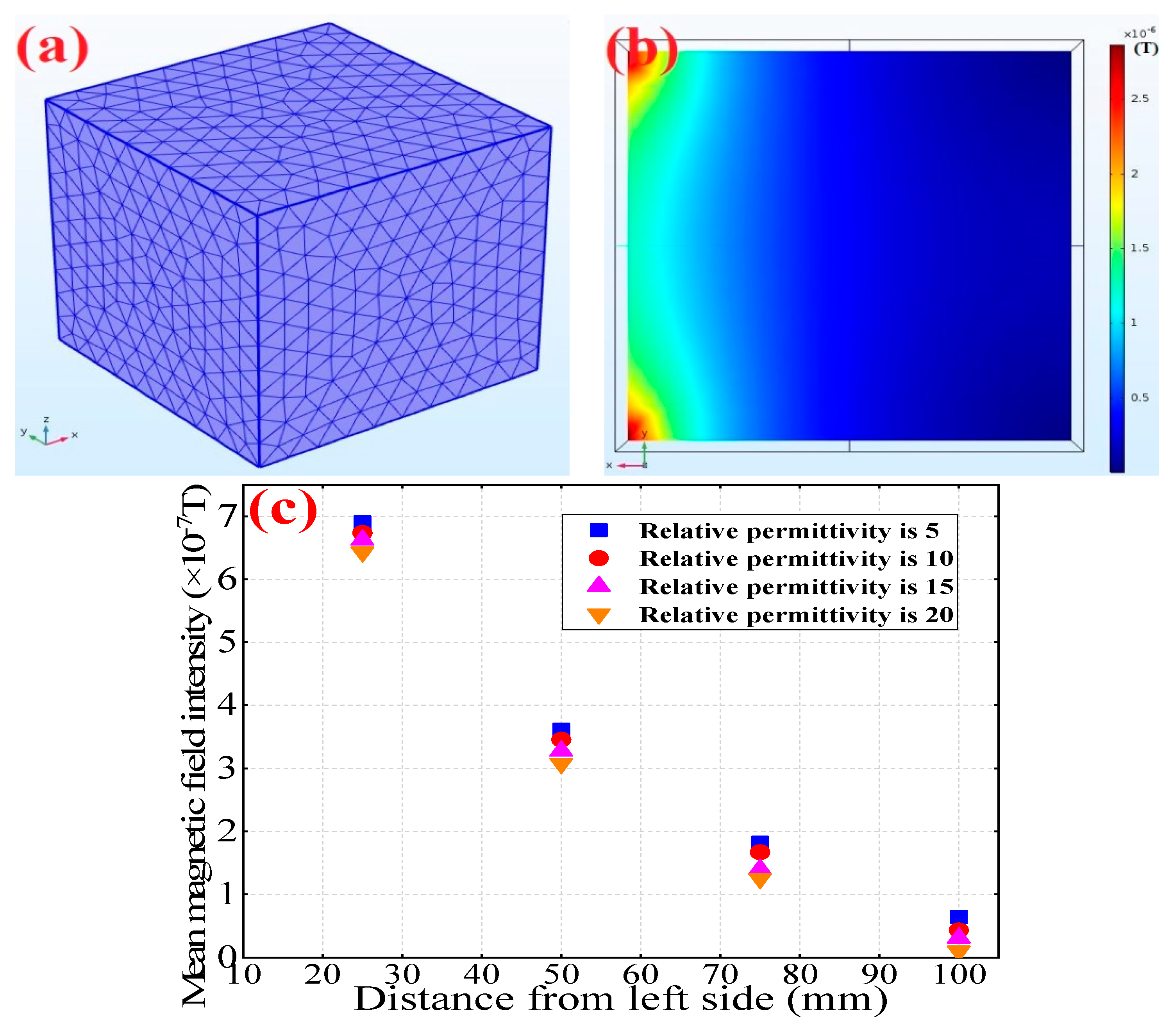
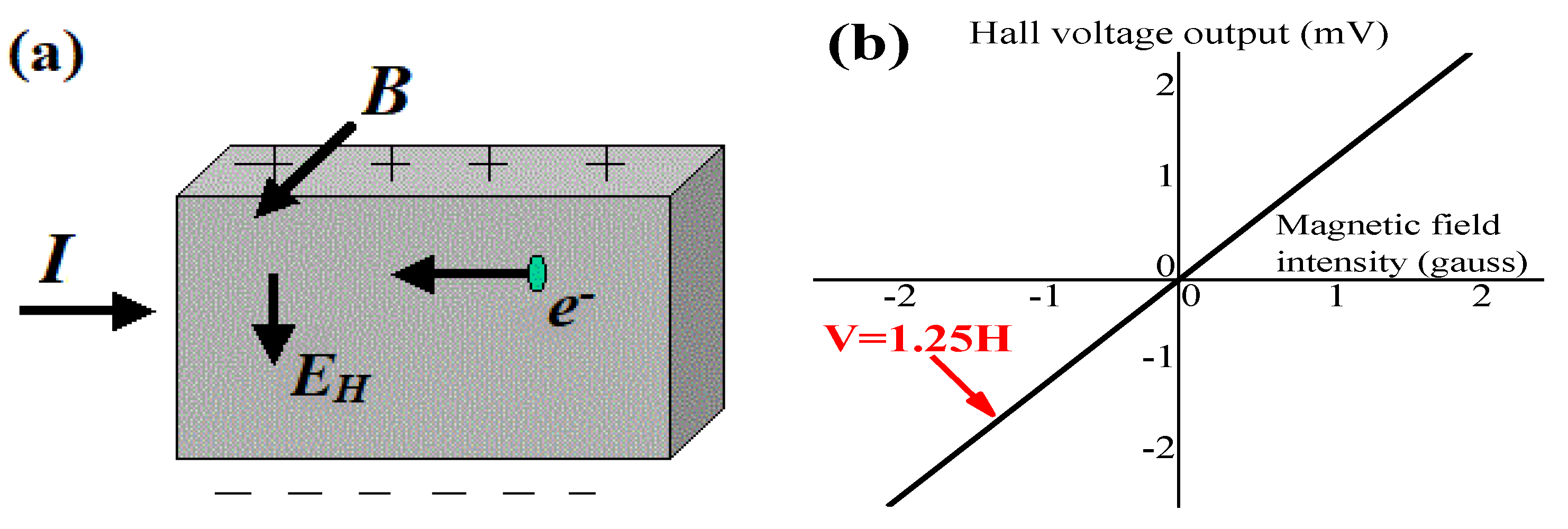
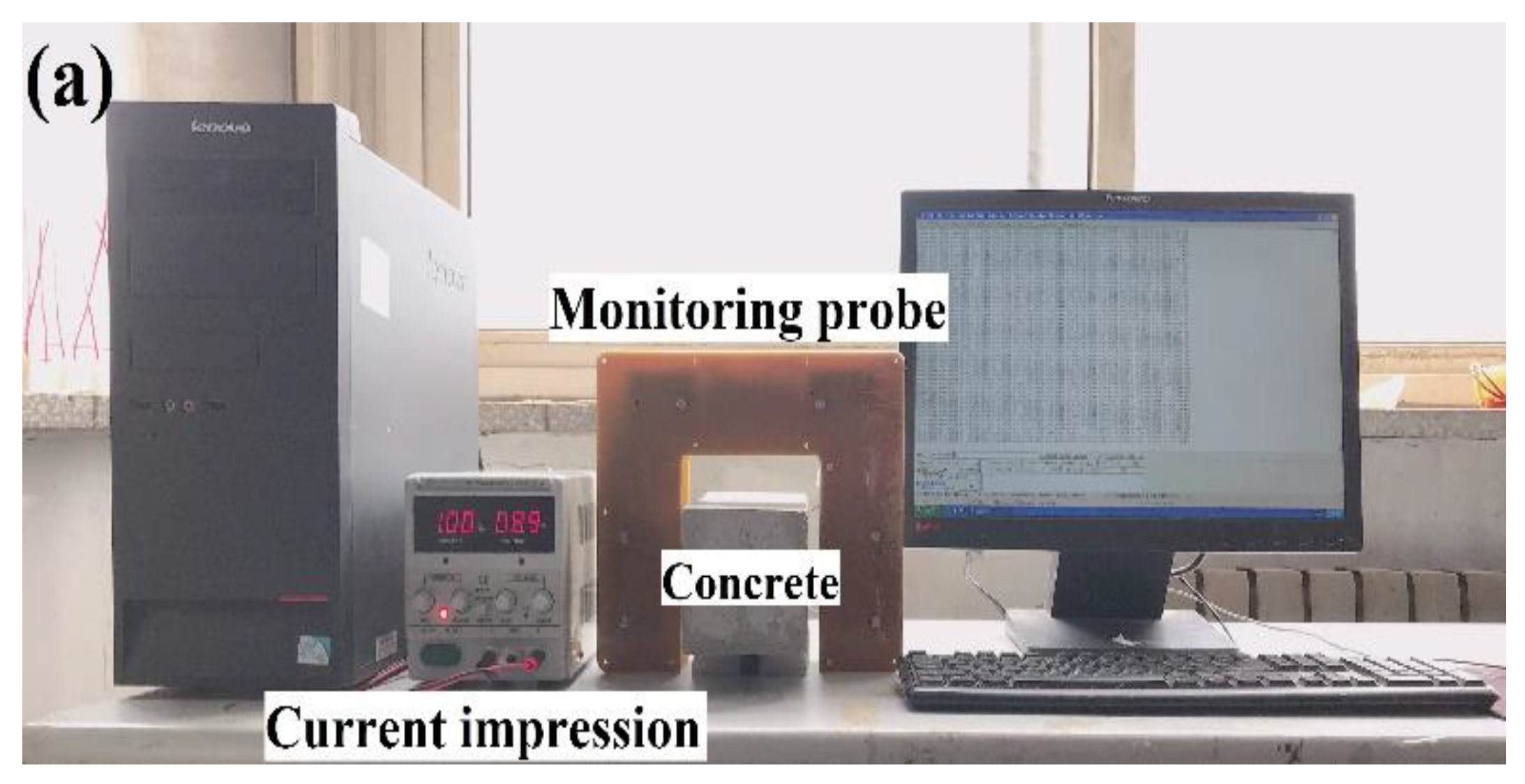

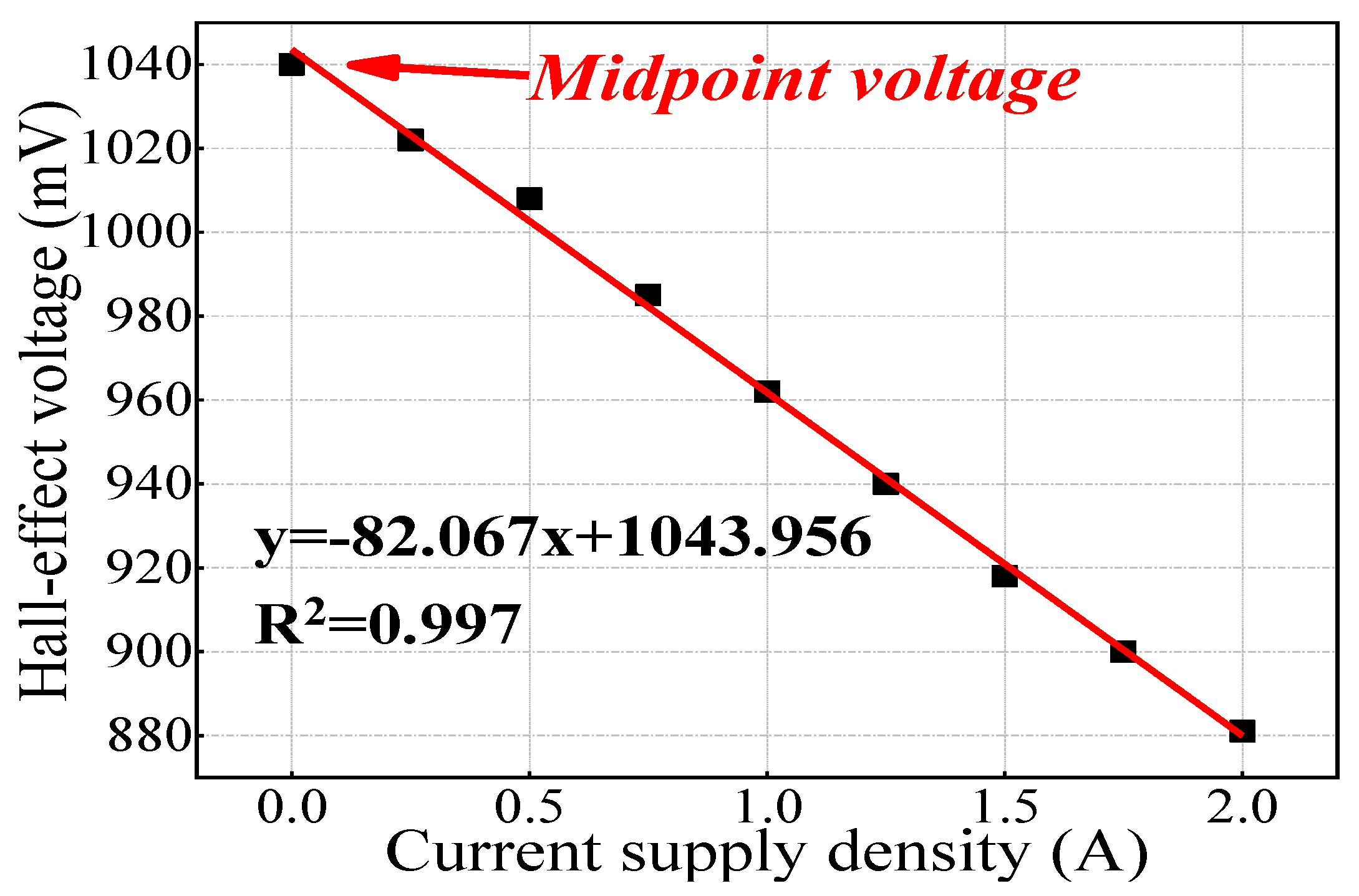
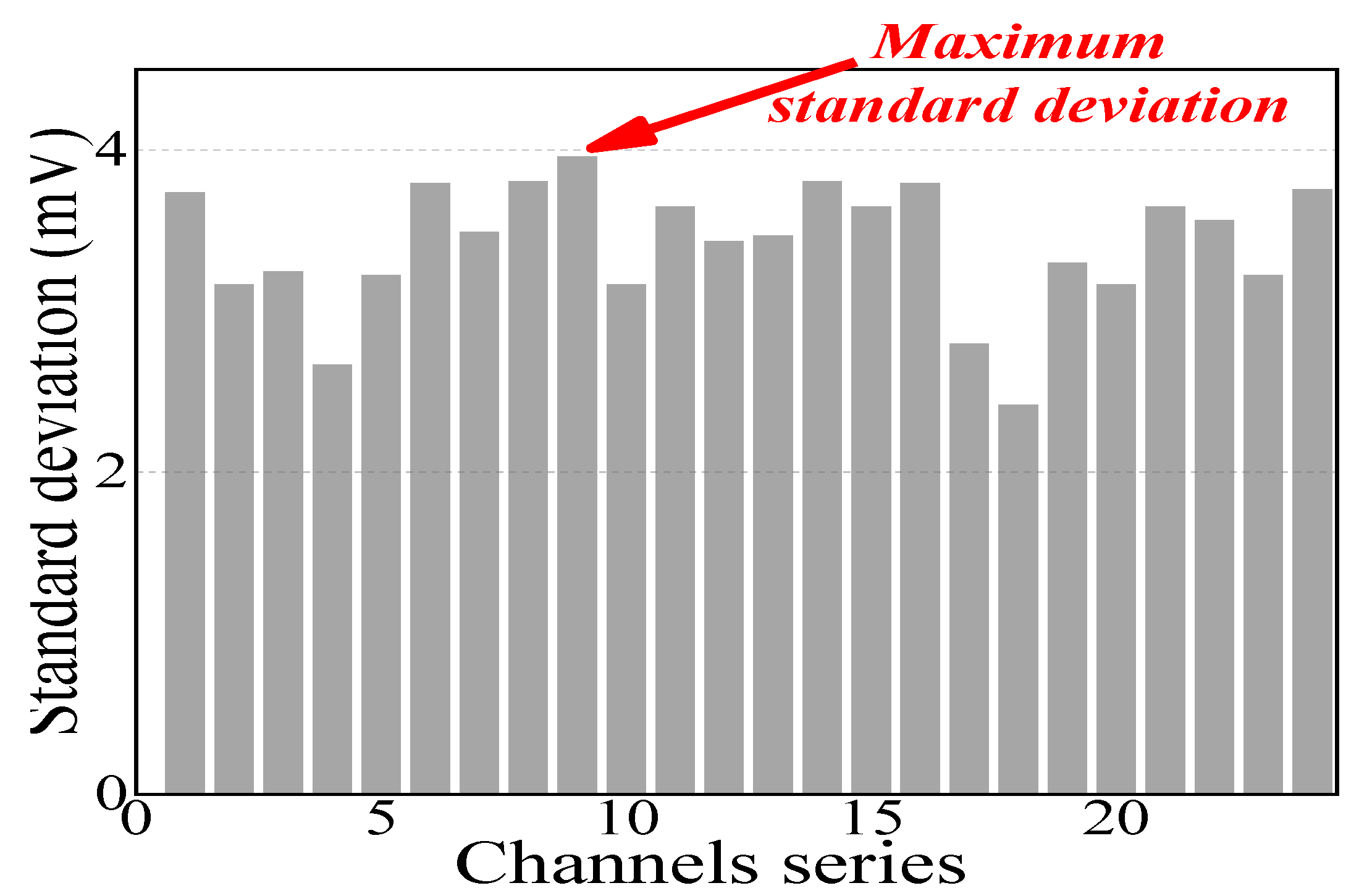
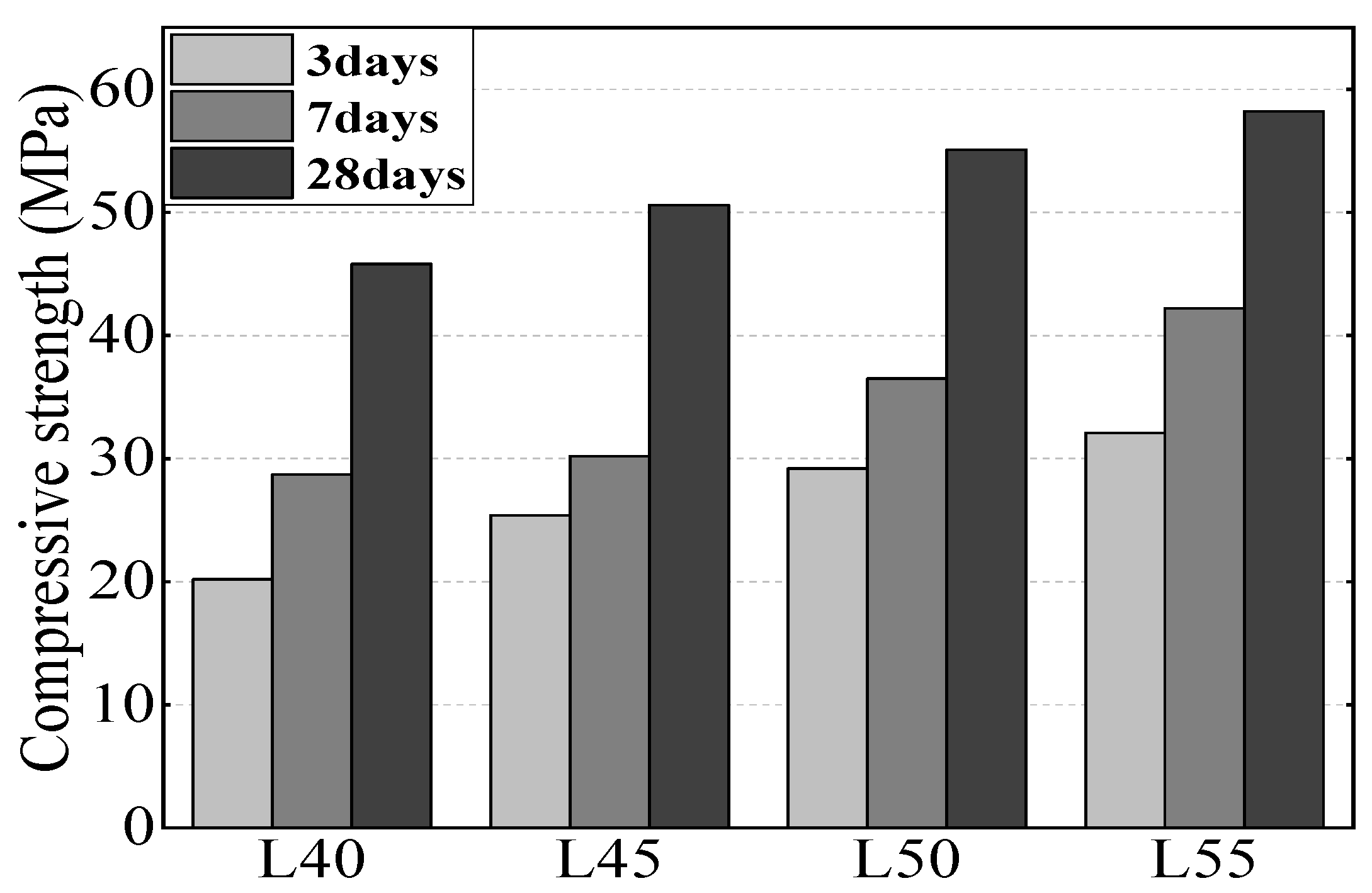


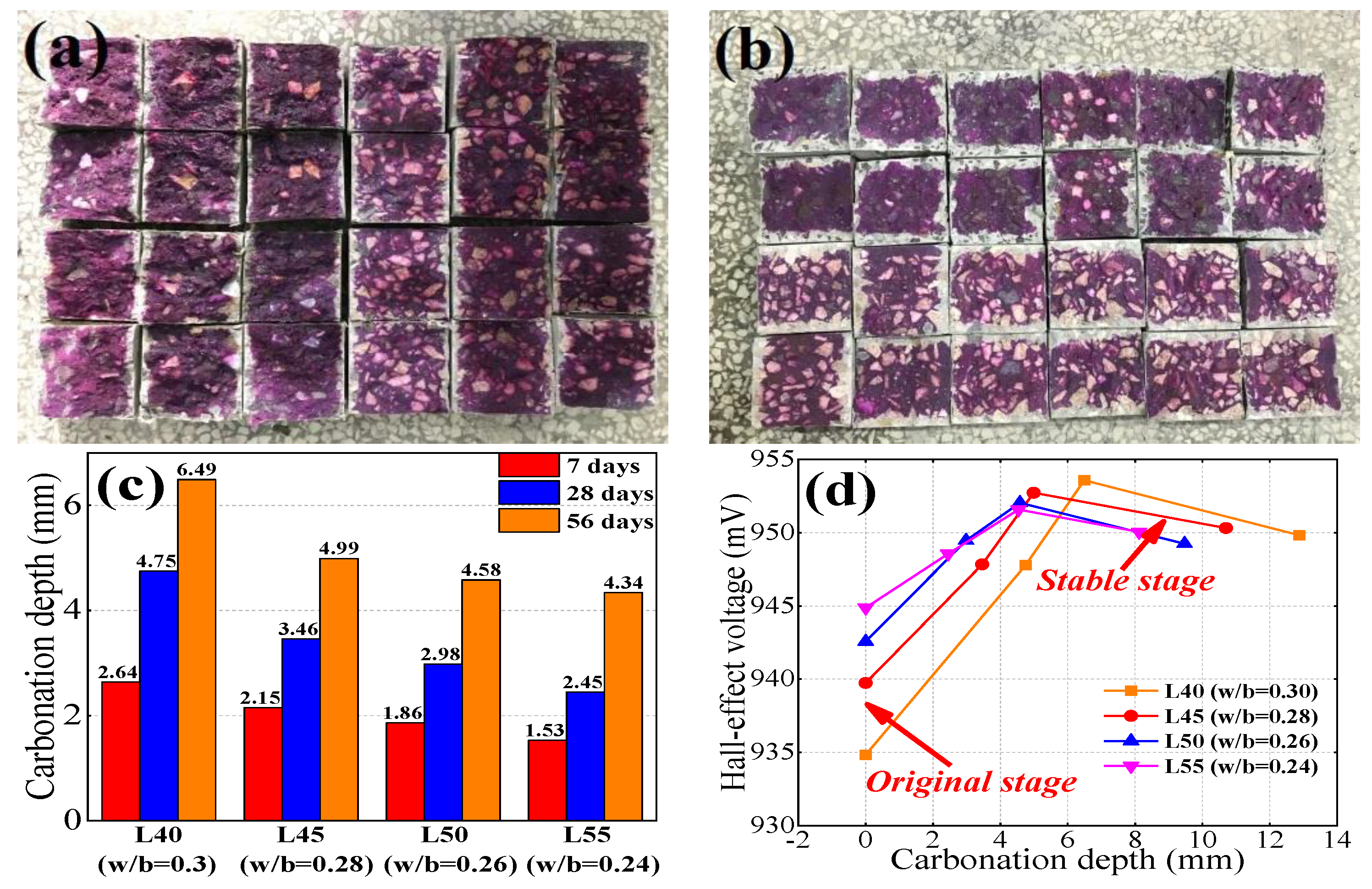


| Constituent | SiO2 | Al2O3 | Fe2O3 | CaO | MgO | Na2O | K2O | SO3 | P2O5 |
|---|---|---|---|---|---|---|---|---|---|
| Cement | 19.80 | 4.18 | 3.63 | 62.03 | 4.48 | 0.96 | 0.48 | 1.88 | 0.10 |
| GGBS | 32.58 | 13.27 | 1.34 | 41.06 | 5.62 | 0.45 | 0.54 | 2.68 | 0.04 |
| Fly ash | 56.90 | 13.70 | 4.40 | 1.96 | 0.32 | 0.17 | 1.10 | 0.57 | 0.10 |
| Density (kg/m3) | Fineness | Particle Size (3–65 µm, %) | |
|---|---|---|---|
| Cement | 3050 | 360 m2/kg (specific surface area) | 82.93 |
| GGBS | 2810 | 379 m2/kg (specific surface area) | 75.45 |
| Fly ash | 2050 | 10.5% remained (45 μm griddle) | 78.65 |
| Binder | Cement | GGBS | Fly Ash | Sand | Granite Stone | Super Plasticizer | Water | w/b | |
|---|---|---|---|---|---|---|---|---|---|
| L40 | 346 | 173 | 86 | 86 | 780 | 1169 | 4.5 | 104 | 0.3 |
| L45 | 384 | 192 | 96 | 96 | 761 | 1142 | 5.0 | 108 | 0.28 |
| L50 | 435 | 217 | 109 | 109 | 738 | 1108 | 5.7 | 113 | 0.26 |
| L55 | 474 | 237 | 118 | 118 | 721 | 1081 | 6.2 | 119 | 0.24 |
| pH | |||||||
|---|---|---|---|---|---|---|---|
| 12.76 | 161.29 | 2176.12 | 17,533.33 | 407.83 | 1177.38 | 6.98 |
| Accuracy of Temperature (°C) | Accuracy of Relative Humidity (RH) | Temperature Range (°C) | RH Range | Working Voltage (V) | Channels |
|---|---|---|---|---|---|
| 0.1 | ±2% | –40 to 80 | 0–100% | 5 | 4/8/16 |
| w/b | Fitting Formula (Ascending Stage) | Fitting Formula (Descending Stage) | Critical Point (Ratio to RH 98%) | Correction Factor (Descending Stage) | Correction Factor (Descending Stage) |
|---|---|---|---|---|---|
| 0.30 | yA = –1.671x + 1162.286 (R2 = 0.999) | yD = 0.401x + 958.067 (R2 = 0.996) | 98% (1) | 1 (standard) | 1 (standard) |
| 0.28 | yA = –1.078x + 1106.278 (R2 = 0.985) | yD = 0.463x + 960.697 (R2 = 0.994) | 96% (0.98) | 1.55 | 1.15 |
| 0.26 | yA = –0.768x + 1007.194 (R2 = 0.976) | yD = 0.544x + 956.493 (R2 = 0.993) | 94% (0.96) | 2.17 | 1.36 |
| 0.24 | yA = –0.740x + 1076.206(R2 = 0.980) | yD = 0.580x + 961.198 (R2 = 0.998) | 90% (0.92) | 2.26 | 1.45 |
| w/b | Fitness Formula | Correction Factor |
|---|---|---|
| 0.30 | yC = 2.855x + 934.704 (R2 = 0.998) | 1 (standard) |
| 0.28 | yC = 2.559x + 939.563 (R2 = 0.994) | 1.12 |
| 0.26 | yC = 2.101x + 942.732 (R2 = 0.993) | 1.36 |
| 0.24 | yC = 1.477x + 944.901 (R2 = 0.999) | 1.93 |
| w/b | Water Absorption Coefficient (g/m2h0.5) | Correction Factor |
|---|---|---|
| 0.30 | 85.43 | 1 |
| 0.28 | 81.89 | 1.04 |
| 0.26 | 74.01 | 1.15 |
| 0.24 | 65.07 | 1.31 |
© 2019 by the authors. Licensee MDPI, Basel, Switzerland. This article is an open access article distributed under the terms and conditions of the Creative Commons Attribution (CC BY) license (http://creativecommons.org/licenses/by/4.0/).
Share and Cite
Li, Z.; Jin, Z.; Shao, S.; Zhao, T.; Wang, P. Influence of Moisture Content on Electromagnetic Response of Concrete Studied Using a Homemade Apparatus. Sensors 2019, 19, 4637. https://doi.org/10.3390/s19214637
Li Z, Jin Z, Shao S, Zhao T, Wang P. Influence of Moisture Content on Electromagnetic Response of Concrete Studied Using a Homemade Apparatus. Sensors. 2019; 19(21):4637. https://doi.org/10.3390/s19214637
Chicago/Turabian StyleLi, Zhe, Zuquan Jin, Shuangshuang Shao, Tiejun Zhao, and Penggang Wang. 2019. "Influence of Moisture Content on Electromagnetic Response of Concrete Studied Using a Homemade Apparatus" Sensors 19, no. 21: 4637. https://doi.org/10.3390/s19214637






